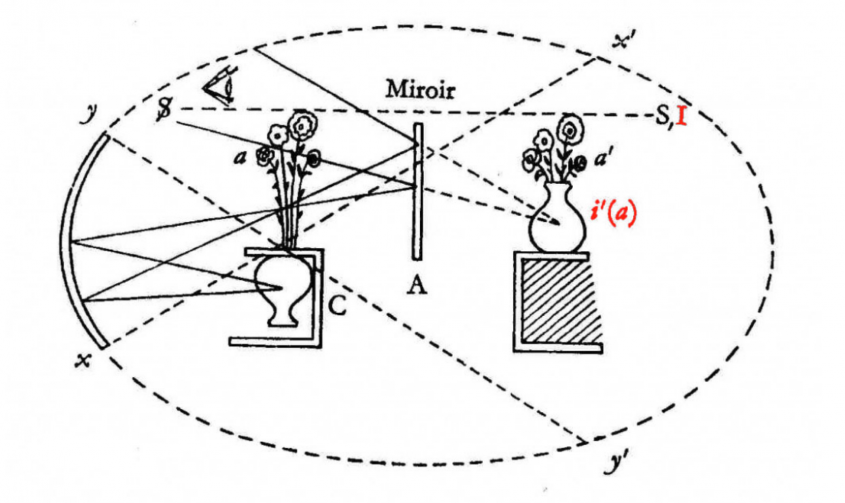
La theorie c’est bon, mais ca n’empeche pas d’exister. Jean-Martin Charcot
Theorie ist gut, ändert aber nichts daran, dass es Dinge gibt die nicht zu ihr passen.
Jahresprogramm 2018
Was nicht gesagt werden kann, muss gezeigt werden. Der berühmte letzte Satz aus Wittgensteins Tractatus – “Wovon man nicht sprechen kann, darüber muss man schweigen.” – birgt ein offensichtliches Paradox: Er enthält ein überflüssiges Verbot, denn er untersagt etwas, das ohnehin unmöglich ist.
Im Jahre 1961 riefen mehrere Künstler u.a. die Malerin Helen Frankenthaler, die Maler Willem De Kooning, Robert Motherwell und Ad Reinhardt zu einem Boykott des kulturellen Lebens der Stadt New York auf. Sie reagierten damit auf das mangelnde Interesse der Stadt New York, Künstlern und Künstlerinnen leerstehende Industrielofts, vorwiegend in Manhattan, als leistbare Ateliers zur Verfügung zu stellen. Dieser Boykott rief dazu auf der Kunst zu einer gleichberechtigten Position in der Gesellschaft zu verhelfen. Diverse künstlerische Produktionen und Aktivitäten sollten so zu einem sichtbaren konstitutiven und dauerhaften Element werden. Dieser Hinweis auf eine „Neupositionierung“ der Kunst inmitten der Gesellschaft weißt auf die Notwendigkeit hin dem systematischen Zugewinn an externer Kompetenz und externer Kultur, den nur die Kunst alleine leisten kann, Raum zu geben. Dies scheint geradezu eine Bedingung für die Weiterentwicklung einer urbanen Identität unserer Gesellschaft zu sein. Dieses Ereignis markiert einen Wendepunkt im Selbstverständnis der Künstler, insbesondere der Maler und Malerinnen, gegenüber der Öffentlichkeit. Nur Teil zu sein, im besten Fall einer Bohème, war nicht länger zufriedenstellend. Die künstlerische Produktion sollte als das wahrgenommen werden was sie ist, „Painting Intellect“ und „Participative Intellectualism“. Dieser Boykott stellt somit einen Paradigmenwechsel in der Geschichte der Zeitgenössischen Kunst dar. Auch unsere Zeit, unsere Gesellschaft braucht einen solchen Paradigmenwechsel dringender den je.
Jenseits der Fiktion der Realität gibt es die Realität der Fiktion. Ganz grundlegend lautet die Formel “Epur si muove”.Bewegung ist das Streben nach der Leere, d.h. Die Dinge bewegen sich, es gibt etwas und nicht nichts, nicht weil sie weniger ist als nichts. Die Realität braucht die Ergänzung durch die Fiktion, um diese ihre Leere zu verbergen. Wir stellen uns die Frage, ist Kunst Realität oder Fiktion? Wo werden sie sichtbar, die Grenzen zwischen dem Privaten und dem Öffentlichen? Argumentiert Kunst auf einer Ebene der kritischen Distanz, oder auch auf einer Ebene der Empathie? Ist Kunst nur in einem Zustand der Getriebenheit möglich und ist also Getriebenheit das grösste Glück?
2018 stellt fAN den Künstlerinnen und Künstlern eine Plattform, einen Freiraum für ihre fiktionalen Erzählungen zur Verfügung. Aus dem Kontext der Kunst wirken diese in eine breite Öffentlichkeit. In einer Zeit in der der öffentliche Raum verschwindet, in der der Rückzug ins Private befördert wird, ist es um so wichtiger Räume des Experiments, der nicht- kommerziellen Nutzung der Gesellschaft zugänglich zu machen. Externe Kompetenz, das „Fremde“, wie dies auch Georg Simmel in seinem „Exkurs über den Fremden“ (vgl. 1992) bemerkt, ist eine wesentliche Bedingung für eine urbane Gesellschaft, für die Möglichkeit einer kulturellen Entwicklung. Der Fremde und das Fremde, die Differenz und die Anonymität, sind in einer urbanen Gesellschaft eben nicht nur als Gäste präsent wie in der Kleinstadt, sondern treten als konstitutives und dauerhaftes Element auf. Die Kunst darf nicht vereinnahmt werden, nicht als Mittel zum Zweck benutzt werden, sondern in erster Linie sollte ihr Selbstverständnis gestärkt und somit unsere Grundwerte verteidigt werden. Eine wichtige Aufgabe der s.g. Off-Spaces ist es im öffentlichen Raum dafür zu sorgen, dass es einer bleibt. Non-profit Spaces sind Räume des Experiments, des Unkontrollierbaren und dieses Potential gilt es zu erhalten.
Lacan, optisches Modell; erstmals verwendet im Seminar 1 von 1953/54, Freuds technische Schriften.
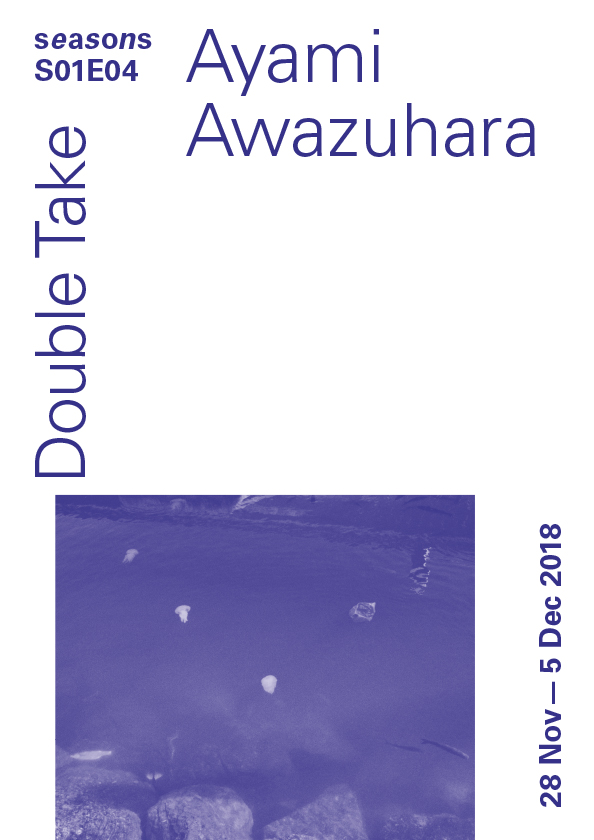
Seasons S01 E04.
Double Take
Ayami Awazuhara
Opening: Wednesday, November 28, 2018, 7pm
Venue: fAN Kunstverein @ SORT Bäckerstraße 7/8 1010 Wien
Duration: November 28 – December 5, 2019
Opening Times: by appointment
“Everyone has a car: the millionaire has one; the hired man has one; the hobo has one. And their cars go much more quickly than our cars, because the roads are as smooth as billiard balls and very straight.”
Virginia Woolf ‘America, which I Have Never Seen’
In one of the many wonderful essays she wrote throughout her life, the British writer Virginia Woolf turned her attention to the United States of America. There was just one tiny problem; she had never been there before. Instead, she transformed the noun “Imagination” into a proper noun and had her fly over to this mysterious continent and report back with her findings.
In doing so, Woolf became one of many writers who have used their imaginations, rather than their memories, to conjure up physical locations in the minds of their readers. There were some who went even further and invented entirely imaginary places; In Invisible Cities (1972), for instance, Italo Calvino dedicated an entire novel to descriptions of 55 fictitious cities, and in René Daumal’s posthumously published work, Mount Analogue (1959), the main character goes in search of a fabled mountain whose peak bridges the gap between the earth and the heavens.
A copy of this book sits on Ayami Awazuhara’s desk and has been vigorously thumbed through by the artist. Daumal was the first writer to use the word “peradam” to mean “an object that is only revealed to those who seek it”, which is fitting because – particularly in her sculptural and text-based works – much of Awazuhara’s practice requires an act of good faith by its audience. Or, in other words, they have to want to believe in something before they can hope to discover it.
Her series Landscape Charts (2017), for example, uses text – “stream, evergreen, pebble” – to graphically create images in the vein of concrete poetry, but require the audience’s imagination to be fully completed. Awazuhara is interested in “how to tell stories” but ones which “you [can] imagine by yourself”. The pieces might look minimal, anti-visual even, but at its core the series is about our limitless potential to create images in our mind’s eye.
Like Woolf, Awazuhara is interested in how to imagine a landscape that either herself or the viewer has never seen before. In previous works, such as Possible Woods (2016), a room-sized installation of green metal and wool, that fabricated place was a jungle, but for her exhibition at fAN Kunstverein, Awazuhara recreates arctic landscape. Through limited means – a box, blue plastic, bits of metal, tape, the glow of a projected film – she suggests a path our eyes could take. It’s up to us whether or not we want to follow.
Text by Chloe Stead
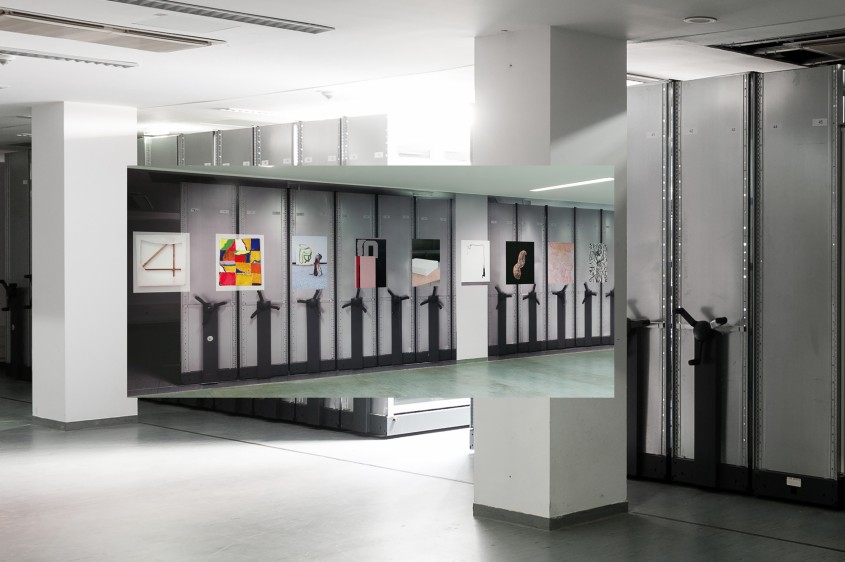
Parallel Vienna 2018
Opening: Tuesday, September 25, 2018, 7pm
Venue: Parallel Vienna 2018, Lasallestrasse 1, 1020 Vienna, 1st Floor Room 1.14
Duration: September 25 – September 30, 2018
Opening Times: Tuesday 17:00-22:00, Wednesday – Sunday 12:00-19:00
Exhibition concept/ graphic design by Herwig Müller @ fAN
Artists Selection: Fabian Seiz, Bobby Dowler, Irene Gellein, Gregor Eldarb, Kristin Kelich, Anna Paul, Anna Grath, Maja Vukoje, Anna Schachinger, Victoria Roth, Giorgos Kontis, Bianca Regl, Eiko Gröschl, Gerlind Zeilner, Dejan Dukic, Ewa Kaja, Valentin Postlmayr, Elisabeth von Samsonow/ Juergen Teller
fAN Archive: A great narrative emerges from the interplay of all the artistic positions shown so far in the Kunstverein fAN and all coming artistic positions. The selected examples deal with moments of exchange and artistic cooperation. They follow the processes of appropriation and transformation of ideas, attitudes and objects. Since 2015, the Kunstverein fAN has been trying to create a quasi informal, independent place that concentrates on the handicraft of exhibition making. The entire programming of fAN, ideally, represents a coherent and linear group show. The individual positions are supported by an artistic practice that represents a close relationship to their material vocabulary.
The Kunstverein fAN has made it its business to present, preserve, interpret and represent contemporary art, especially forms that are vulnerable to institutional neglect, cultural bias, its transience or politically unpopular contents. fAN aims to offer this artists both physical and virtual places for the presentation.
Artists from the fAN archive: Irini Athanassakis, Matthias Bernhard, Daniel von Bothmer, Rainer Bros, Chin Tsao, Antoine Donzeaud, Bobby Dowler, Dejan Dukic, Rouven Dürr, Eden & Lernout, Gregor Eldarb, Peter Eramian, Michael Fanta, Katharina Farnleithner, Line Finderup Jensen, Anna Grath, Irene Gellein, Eiko Gröschl, Johanna Guggenberger, Ewa Kaja, Stelios Karamanolis, Kristin Kelich, Reinhold Kirchmayr, Giorgos Kontis, Bruno Kratochvil, Johannne Rude Lindegaard, Juliana Lindenhofer, Victor Lizana, Melanie MacLain, Irini Miga, Panos Papadopoulos, Anna Paul, Tula Plumi, Valentin Postlmayr, Bianca Regl, Maresi Riegner, Victoria Roth, Anna Schachinger, Maja Vukoje, Niclas Riepshoff, Christian Ruschitzka, Elisabeth von Samsonow/Juergen Teller, Fabian Seiz, Pascual Sisto, Just Quist, Franz Vana, Kay Walkowiak, Andreas Werner, Eugen Wist, Gerlind Zeilner
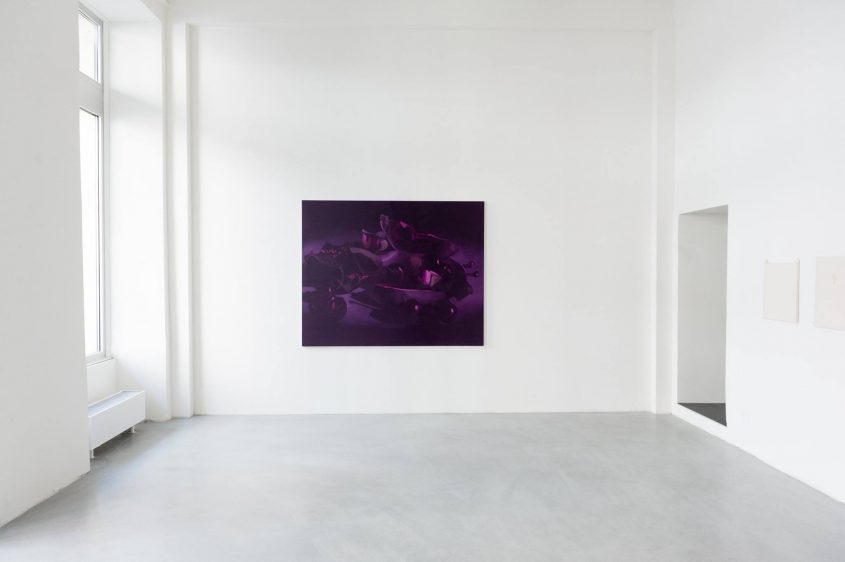
Photo credits: Christoph Liebentritt
fAN Archive
Out of State. Funny Things happened on the Way..
Kristin Kelich, Bianca Regl, Maja Vukoje, Kay Walkowiak.
Opening: Tuesday, August 7, 2018, 7pm
Venue: Offroom Innovation Circle Marxergasse 42, 1030 Wien
Duration: August 7 – September 15, 2018
Only the concentration on the motive of the contact, the multiple transcultural moments of exchange and interrelations, and the investigation of this multifaceted contact is capable of dissolving the dichotomous structures inscribed in the Global Art History. Only in contact and often in conflictual confrontations with others embody phases of change. Artistic and politically interested encounters of at least two actors in the field of tension between cooperation and confrontation seem to hold potential for overcoming the dichotomy of Western and non-European (art) stories.
What, then, are the motives and conditions that enable certain actors to think or do something specific at a certain point in time and thus to exceed the spaces of thought and action assigned to their subject positions?
The artistic positions shown here negotiate, very differently, these aesthetic, ideological and strategic fault lines.
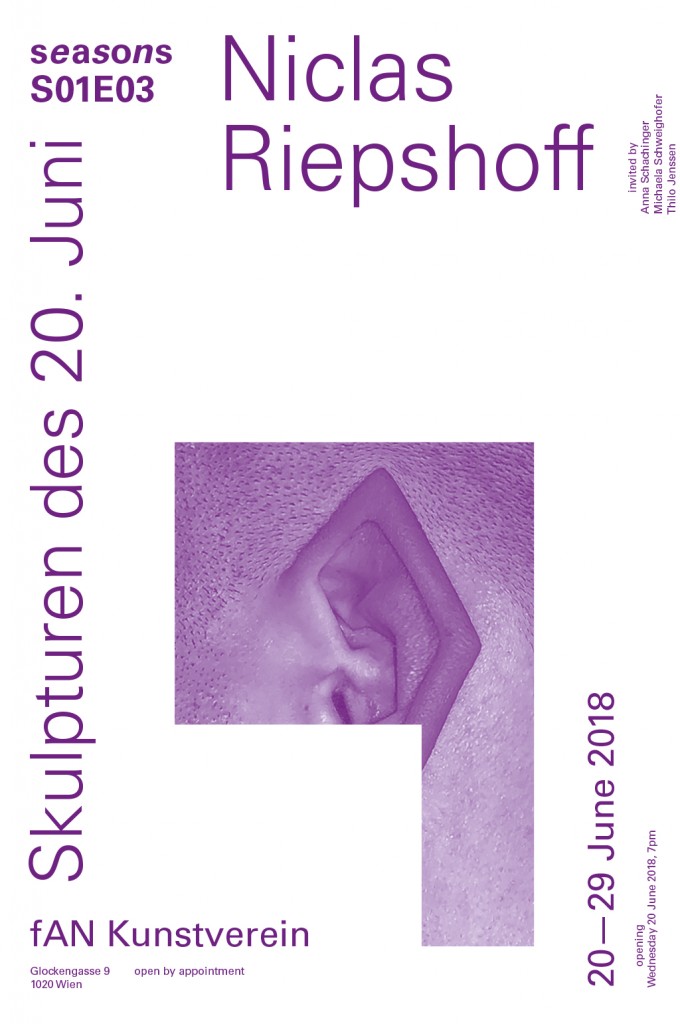
Seasons S01 E03.
Skulpturen des 20. Juni
Niclas Riepshoff
Opening: Wednesday, June 20 2018, 7pm
Venue: Glockengasse 9, 1020 Wien
Duration: June 20 – June 29, 2018
“They fuck you up, your mum and dad.”
Philip Larkin ‘This Be The Verse’
Talking babies and parenthood in the art world is awkward. There is always the implication that you get less serious about your art after becoming a parent. The belief is that art works are fragile, like new-borns, and must be nurtured into maturity. “My work,” many artists declare, “is my baby.”
Niclas Riepshoff doesn’t have any children and, in his own words, “A baby never played a role in my life.” As a gay man it’s not impossible that he might someday start a family, but the decision to do so would be more complicated; it would most likely involve lawyers and contracts and would be dependent on laws that differ from country to country or sometimes state to state. While I’m no therapist, it’s not a stretch to imagine that the objects on display, collectively titled 3 Poses for a Newborn (2018), were influenced by Riepshoff’s ambivalent attitude towards fatherhood. Although instantly recognisable as babies, the four plaster sculptures are not cute but angular and solemn. They do not have squishy bodies and the smell of their skin would not induce adults into fits of cooing adoration. Instead they’re reminiscent of gargoyles, which as well as serving a practical function (they drain rainwater from buildings) are said to ward off evil spirits through their grotesque forms.
The geometric shapes that make up these sculptures are a clear but surface level reference to cubism – surface level because cubism is treated as an historical style rather than an ideological movement. “It’s an aesthetic that I chose… it’s one aesthetic, not the aesthetic that I’m working with,” says Riepshoff. “It has nothing to do with personal taste.” In the past he’s remade two Jugendstil sculptures by Austrian artist Richard Luksch out of Paper Maché (This is how we Stand, 2017), created a series of five black & white woodcuts based on a forest of crooked trees in Poland (Krzywy Las- Fantasien des Verlustes, with Sarah Ksieska, 2018) and staged a collaborative Dadaist theatre play (Doubt on the 5th Floor, with Tanja Nis Hansen, 2017). That is to say, there is an inquisitive to Riepshoff’s practice that sees him constantly learning new techniques – and as a result no two projects look alike.
Often, the research process involves learning from experts in their respective fields. For example, when Riepshoff wanted to recreate the sound of the wind whistling through the high-rise buildings of Frankfurt (where he had recently moved for his studies) he worked with an organ builder to learn as much as he could about the process so that he could create his own automated wind instruments. The result, Sketch for an Organ, 2018, acts as a test for a planned installation that will incorporate both the sound and the famous skyline of Frankfurt’s corporate buildings. For now, though, the installation remains loose and low-fi, offering a counterpoint to what Riepshoff called the ‘completeness’ of the baby sculptures, as well as ‘music’ for them to listen to as they slumber.
Text by Chloe Stead
Niclas Riepshoff (1992) was born in Bremen, Germany. He has studied at Hochschule für bildende Künste Hamburg, California Institute of the Arts (Calarts) and is currently studying at the Städelschule Frankfurt am Main in the class of Judith Ho.
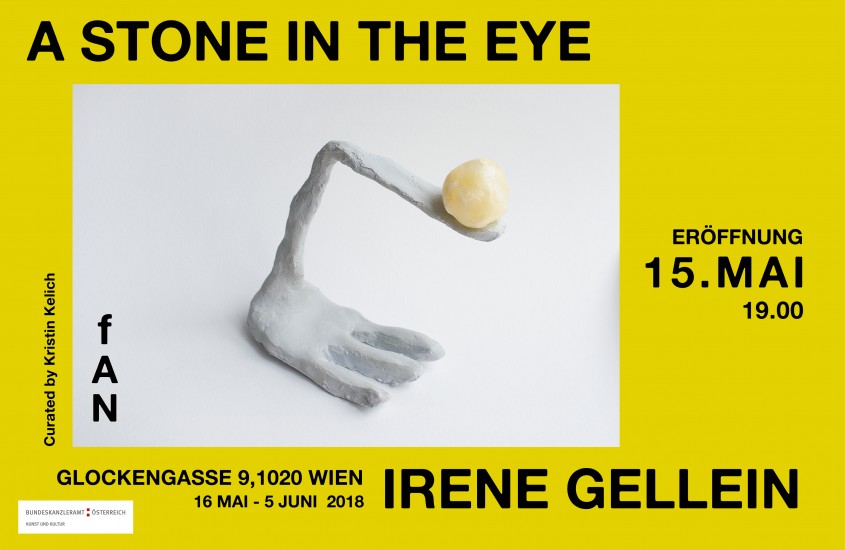
A Stone in the eye
Irene Gellein
Opening: Tuesday, May 15 2018, 7pm
Venue: Glockengasse 9, 1020 Wien
Duration: May 16 – June 5, 2018
Curated by Kristin Kelich.
The Elements of Style (1917) is a slim volume on grammar and composition, which – despite being over 100 years old – is still so popular in the English-speaking world that it’s never been out of print. Written by an English professor, the book is full of practical, no-nonsense pointers, but its biggest gem is this one: “Vigorous writing is concise”. The author goes on to elaborate that “A sentence should contain no unnecessary words, a paragraph no unnecessary sentences, for the same reason that a drawing should have no unnecessary lines and a machine no unnecessary parts. This requires… that every word tell.”
The professor’s advice reminds me of a life-drawing teacher I once had who would chastise us for making repetitive “scratchy” lines with our charcoal. It was a difficult habit to break – the extra lines made us feel more creative in the same way that added words help a novice writer feel cleverer. With all the noise gone, we were able to see clearly whether the bodies we were creating on our easels were a true representation of the bodies posing in front of us.
It’s this economy of means which makes Irene Gellein’s drawings so compelling. In her works, a couple of dashes and smudges of aquarelle more than adequately suggests the anger and sadness of her subject (Sur sur), or a few strokes of a pen can easily capture the intimacy and awkwardness of a hug (Hugs). Gellein knows that to make a likeness of someone its not necessary to render him or her completely; rather that, as the English painter Sir Joshua Reynolds put it, likeness “consists more in the general air than in the exact similitude of every feature.”
Gellein’s sculptures also exist within this “general air” of likeness. Chicken is a near perfect replica of an oven-ready chicken – the fact that it’s 3D assures us it’s anatomically correct – but it could also fit into your hand. I’d argue this makes it a better likeness; after all, the sculpture is exactly as ridiculous as seeing a naked trussed-up chicken in real life. The pairing of Chicken with other miniature sculptures, often-witty assemblages of found materials, is done with the same apparent ease as the drawings. This is a good thing: to quote another famous piece of advice (a design principle from the U.S Navy but equally applicable to all the arts), when communicating one should always KISS. Or, in other words, “keep it simple stupid!”
Text by Chloe Stead
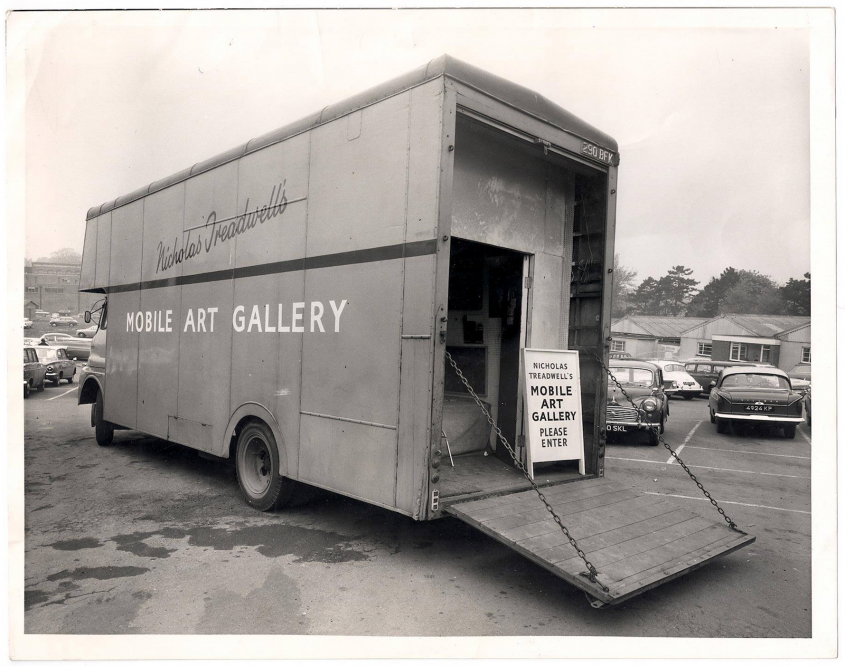
Mobile Art Gallery
April 2018
We live in an age of modern nomadism, which is one of the reasons why fAN follows an idea of a mobile, temporary art space. We are developing a multifunctional, small pavilion that enables an independent encounter between art and the city. However, art should not be a “creative catalyst”, but should become visible as a socially relevant factor. The emancipatory power of art makes it possible to integrate the “foreign” in an identity-forming way for our society, not to understand the public as a place of “nest-warm” communities, on the contrary to create an image of what the right to society, the right to disputable art and the right to a diverse community represents, a venue for our meager society. This new art space is supposed to be a sign of that. The public space as sculpture. We try the impossible. The impossible, so Jacques Derrida, gives movement to the desire, the action and the decision.